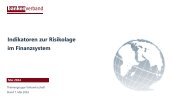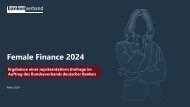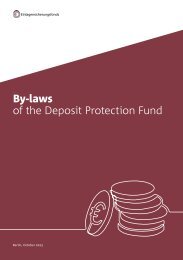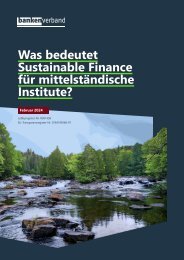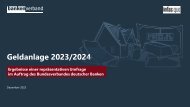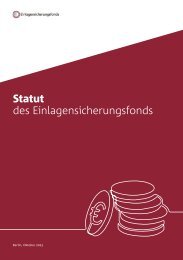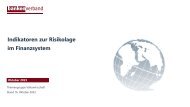Regulation of shadow banking
Shadow banking is given a large share of the blame for the financial crisis. This perception raises the question of what kind of shadow banking system should remain in place in the future.
Shadow banking is given a large share of the blame for the financial crisis. This perception raises the question of what kind of shadow banking system should remain in place in the future.
Create successful ePaper yourself
Turn your PDF publications into a flip-book with our unique Google optimized e-Paper software.
3<br />
bankenverband<br />
The legislative framework<br />
Shadow <strong>banking</strong> in the US and Europe differs greatly<br />
in terms <strong>of</strong> both its structure and importance for<br />
the financial markets. 9) So it is no surprise that the<br />
framework for regulation and oversight <strong>of</strong> <strong>shadow</strong><br />
<strong>banking</strong> by the FSB and EU, on the one side, and the<br />
US, on the other, was set very differently. The FSB<br />
and the EU first examined <strong>shadow</strong> <strong>banking</strong> entities<br />
and their activities to determine how far they carry<br />
systemic risks. Building on this, they then drafted<br />
recommendations for regulation geared to the nature<br />
<strong>of</strong> these risks. The EU benefits noticeably in this area<br />
from the FSB’s systematic groundwork.<br />
The US, on the other hand, did not address <strong>shadow</strong><br />
<strong>banking</strong> separately as part <strong>of</strong> the non-bank financial<br />
sector. Shadow <strong>banking</strong> entities and their activities<br />
have been treated so far mainly in their capacity<br />
as non-bank SIFIs. 10) While the Financial Stability<br />
Oversight Council (FSOC) does not use the term<br />
“<strong>shadow</strong> <strong>banking</strong>” in its reports either, it does deal<br />
with its risks, e.g. tri-party repos and money market<br />
funds.<br />
In addition, the FSOC is empowered by Section 120 <strong>of</strong><br />
the DFA to designate specific financial market activities<br />
as systemically important. Yet this does not mean that<br />
an activity designated as systemically important is<br />
automatically subjected to supervisory restrictions.<br />
The FSOC is required to draft recommendations<br />
for regulatory measures and propose these to the<br />
supervisor responsible for overseeing such activities.<br />
The supervisor in question is free to reject the<br />
FSOC’s recommendations, although if it does so, it<br />
must explain why. This procedure has a bearing on<br />
regulation <strong>of</strong> <strong>shadow</strong> <strong>banking</strong> because Section 120<br />
was used in November 2012 to present proposals for<br />
regulation <strong>of</strong> money market funds.<br />
There is no single, ideal approach when it comes<br />
to regulating <strong>shadow</strong> <strong>banking</strong>. The differences<br />
internationally are too great to allow this. Both the<br />
above approaches have strengths and weaknesses. The<br />
FSB/EU approach harbours the danger <strong>of</strong> monitoring<br />
only part <strong>of</strong> the non-bank financial sector and <strong>of</strong><br />
perhaps overlooking institutions and activities posing<br />
systemic risk that are not deemed to belong to the<br />
<strong>shadow</strong> <strong>banking</strong> sector. Since, however, the FSB and<br />
the EU additionally plan to oversee clearing houses,<br />
central counterparties (CCPs) and other financial market<br />
entities, this danger should actually be negligible.<br />
The US approach is basically broader. Yet it suffers<br />
from the fact that, despite the comprehensive<br />
assessment <strong>of</strong> systemic relevance, the size <strong>of</strong> a nonbank<br />
financial institution is ultimately the key criterion<br />
for its classification as a SIFI. The practice so far in<br />
the US unfortunately backs up this conclusion. The<br />
US approach could therefore be blind to systemic<br />
risks posed by smaller but closely interconnected<br />
financial institutions. It is unlikely that US supervisors<br />
will manage to oversee the many different types <strong>of</strong><br />
institution in the non-bank sector properly using a<br />
single classification <strong>of</strong> non-bank SIFIs. This is why the<br />
power given to the FSOC under Section 120 <strong>of</strong> the DFA<br />
to recommend regulation to the competent supervisory<br />
authorities when it identifies systemic risks is probably<br />
more important for the regulation <strong>of</strong> <strong>shadow</strong> <strong>banking</strong>.<br />
A serious drawback <strong>of</strong> Section 120, however, is that the<br />
competent supervisory authorities are not required to<br />
follow the FSOC’s recommendations.<br />
9) See FSB Monitoring Report <strong>of</strong> November 2013: www.financialstabilityboard.org/publications/r_131114.pdf<br />
10) FSB and IOSCO only launched consultation on this aspect in January 2014:<br />
www.financialstabilityboard.org/publications/r_140108.pdf<br />
<strong>Regulation</strong> <strong>of</strong> <strong>shadow</strong> <strong>banking</strong> 13





